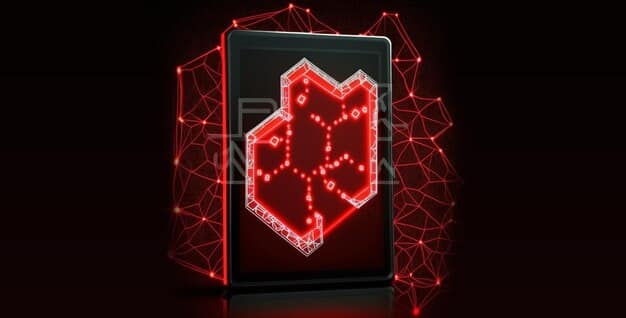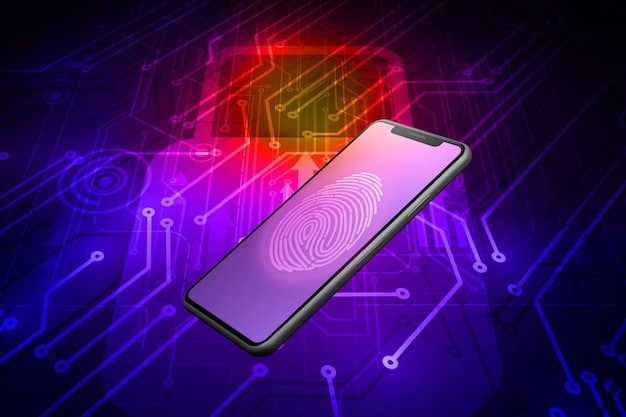Mobile Device Security: 5 Steps for 2025 Data Protection

Effective mobile device security in 2025 necessitates a multi-layered approach, encompassing robust policies, advanced technological safeguards, and continuous employee education to protect sensitive corporate data against evolving cyber threats.
In an era where mobile devices are indispensable tools for business operations, ensuring their security is no longer a luxury but a fundamental necessity. The proliferation of smartphones, tablets, and wearable tech within the enterprise landscape has blurred the lines between work and personal life, introducing unprecedented vulnerabilities. As we look ahead to 2025, the sophistication of cyber threats continues to escalate, making robust mobile device security: 5 critical steps to protect your company’s data in 2025 paramount for organizational resilience and data integrity.
The Evolving Threat Landscape for Mobile Devices
The mobile threat landscape is a dynamic and relentless battleground, constantly shifting with new attack vectors and sophisticated malware. Understanding these evolving threats is the first step toward building an impermeable defense for your company’s valuable data. In 2025, we anticipate adversaries to leverage even more advanced techniques, making proactive security measures indispensable. This involves not only recognizing the threats but also understanding their underlying mechanisms and potential impact on business operations.
Mobile devices, by their very nature, are attractive targets due to their portability, constant connectivity, and the wealth of sensitive data they often contain. From executive emails and proprietary documents to customer profiles and financial records, a compromised mobile device can serve as a direct gateway into an organization’s most critical systems. The sheer volume of devices and their diverse operating systems further complicate the security posture, presenting a complex challenge that demands a holistic and adaptive approach.
Sophisticated Malware and Phishing Campaigns
The sophistication of mobile malware continues to grow dramatically. Traditional viruses have given way to advanced persistent threats (APTs) and ransomware specifically designed for mobile environments. These malicious programs can evade detection, compromise device integrity, and exfiltrate data without the user’s immediate knowledge. Similarly, mobile phishing campaigns are becoming increasingly convincing, often leveraging social engineering tactics to trick employees into revealing credentials or installing malicious apps.
- Zero-click exploits: These highly dangerous attacks don’t require any user interaction, making them extremely difficult to detect.
- Smishing and vishing: SMS-based phishing (smishing) and voice-based phishing (vishing) are on the rise, targeting employees through their primary communication channels.
- Ransomware variants: Mobile ransomware can lock devices or encrypt data, demanding payment for decryption and often disrupting business continuity.
Supply Chain Vulnerabilities and IoT Integration
Beyond direct attacks, the interconnected nature of modern enterprises introduces vulnerabilities through the supply chain. Compromised apps in mobile app stores, insecure third-party software, or even vulnerabilities in device hardware itself can serve as entry points for attackers. Furthermore, as the Internet of Things (IoT) becomes more integrated with enterprise mobile ecosystems, new endpoints and potential weak links emerge, requiring a broader security perspective. The seamless integration of mobile devices with various IoT devices, from smart sensors to connected vehicles, expands the attack surface significantly, demanding comprehensive oversight.
The challenge lies not only in securing the known endpoints but also in identifying and mitigating risks from newly introduced technologies. This necessitates continuous assessment of all connected devices and their potential impact on the overall security posture. Organizations must recognize that mobile devices are merely one component within a much larger, increasingly complex digital ecosystem, where a weakness in one area can cascade throughout the entire network.
Step 1: Implement a Comprehensive Mobile Device Management (MDM) Solution
A robust Mobile Device Management (MDM) solution forms the cornerstone of any effective mobile security strategy. In 2025, MDM platforms have evolved beyond simple device tracking to offer advanced capabilities for configuration, policy enforcement, and threat detection. This goes beyond just locating lost phones; it is about establishing a secure and controlled environment for all mobile endpoints accessing corporate resources. An effective MDM implementation ensures that devices are provisioned securely, adhere to organizational policies, and are constantly monitored for compliance and potential vulnerabilities.
The right MDM allows IT departments to oversee and protect company data on both company-owned and employee-owned (BYOD) devices. It acts as a central command point, enabling IT to deploy applications, enforce security policies, wipe lost or stolen devices, and ensure that all devices accessing the network meet a baseline level of security. Without a comprehensive MDM, managing a large fleet of mobile devices becomes an overwhelming, error-prone, and ultimately insecure task, leaving significant gaps in an organization’s defenses.
Key Capabilities of Modern MDM Solutions
A modern MDM solution should offer more than just basic inventory management. It needs capabilities for granular policy control, application management, and secure access. This includes setting password complexity requirements, encrypting device data, and controlling access to corporate networks and applications based on device posture and user identity. The ability to quarantine non-compliant devices or automatically remediate known issues is also crucial for maintaining a strong security stance.
- Policy Enforcement: Automatically push and enforce security policies like strong passwords, screen lock, and data encryption.
- Application Management: Control which applications can be installed, deploy corporate apps securely, and block risky personal apps.
- Remote Wipe Capabilities: Instantly wipe corporate data from lost or stolen devices to prevent unauthorized access.
- Device Compliance Checks: Continuously monitor devices for compliance with security standards, identifying jailbroken or rooted devices.
Integration with Unified Endpoint Management (UEM)
For even greater control and visibility, organizations increasingly integrate MDM functionalities into a Unified Endpoint Management (UEM) platform. UEM extends beyond mobile devices to manage and secure all endpoints, including laptops, desktops, and IoT devices, from a single console. This provides a holistic view of the entire digital estate, streamlining security operations and ensuring consistent policy enforcement across all devices. The trend towards UEM reflects the growing complexity of IT environments, where a fragmented approach to security is no longer sustainable.
Embracing UEM allows for a more centralized and efficient approach to endpoint security, bridging the gap between traditional IT and mobile device management. This integration provides a unified security posture, reducing the likelihood of overlooked vulnerabilities and ensuring a cohesive defense. The synergy between MDM and UEM creates a more resilient and manageable security framework for the diverse array of devices prevalent in today’s enterprise.
Step 2: Enforce Strong Authentication and Access Control Policies
Even with the most advanced MDM in place, the human element remains a critical link in the security chain. Strong authentication and rigorous access control policies are indispensable layers of defense, ensuring that only authorized individuals can access sensitive company data. In 2025, simply relying on basic passwords is no longer adequate; multi-factor authentication (MFA) and adaptive access controls are the minimum standard. These measures collectively aim to verify user identities with a high degree of certainty and restrict access based on the principle of least privilege, thereby minimizing potential exposure.
The goal is to create a frictionless yet highly secure authentication experience that deters unauthorized access attempts without unduly burdening legitimate users. This involves not only implementing sophisticated technical controls but also fostering a culture of security awareness among employees. Educating users on the importance of strong authentication and the risks of credential compromise is just as crucial as deploying the technology itself.
Multi-Factor Authentication (MFA) as a Standard
MFA adds crucial layers of security by requiring users to verify their identity through multiple methods before gaining access. This could involve something they know (password), something they have (a physical token or smartphone), and something they are (biometrics like fingerprint or facial recognition). Implementing MFA across all corporate applications and access points for mobile devices significantly reduces the risk of credential-based attacks. Compromised passwords become largely ineffective if an attacker cannot provide the second or third factor of authentication, making MFA a formidable barrier.
The shift to remote work and cloud-based services further amplifies the need for MFA. As employees access company data from various locations and networks, simply relying on network perimeter security is insufficient. MFA provides identity-centric security, securing access regardless of location, device, or network. It is arguably the single most impactful step an organization can take to protect against unauthorized access to critical systems and data.

Adaptive Access Control and Least Privilege
Adaptive access control leverages contextual information, such as user location, device health, and time of day, to dynamically adjust access permissions. For example, if a user attempts to log in from an unusual location or a non-compliant device, the system might prompt for additional verification or deny access altogether. Complementing this is the principle of least privilege, ensuring that users are granted only the minimum access rights necessary to perform their job functions. This limits the potential damage if an account is compromised.
| Key Authentication Feature | Benefit for Mobile Security |
|---|---|
| 🔐 Multi-Factor Authentication (MFA) | Significantly reduces risk of credential theft, even if passwords are compromised. |
| 📍 Adaptive Access Policies | Authenticates users based on context (location, device health), adding dynamic security. |
| 🔑 Principle of Least Privilege (PoLP) | Minimizes damage by restricting user access to only what is absolutely necessary. |
| 🔄 Continuous Authentication | Monitors user behavior and device posture post-login for ongoing security. |
This dual approach of adaptive access and least privilege ensures that even if an attacker gains initial access, their ability to navigate and exfiltrate data from the corporate network is severely curtailed. It’s a proactive defense mechanism that assumes breaches are possible and focuses on limiting their scope. By integrating these strategies, organizations can establish a more resilient access framework, significantly bolstering their mobile security posture against a variety of sophisticated attacks.
Step 3: Encrypt All Data, Both At Rest and In Transit
Data encryption is a non-negotiable security measure in the modern enterprise, particularly concerning mobile devices. Given the inherent risk of device loss or theft, ensuring that data is unreadable to unauthorized parties – whether it’s stored on the device (at rest) or being transmitted across networks (in transit) – is paramount. In 2025, advanced encryption standards are essential, not just for compliance but as a fundamental layer of defense against data breaches. Unencrypted data, if compromised, constitutes an immediate and severe security incident, leading to significant financial and reputational damage.
Effective encryption renders data useless to attackers even if they manage to gain access to the device or intercept network communications. This provides a crucial last line of defense, mitigating the impact of a successful breach. Organizations must adopt a comprehensive encryption strategy that covers all relevant mobile data, extending from the device’s storage to cloud backups and inter-application communications. This holistic approach ensures consistent protection across the entire data lifecycle within the mobile ecosystem.
Full Device Encryption and Secure Storage
Modern mobile operating systems (iOS and Android) offer robust full device encryption features. Activating these features is the first critical step to protect data at rest. This encrypts all data stored on the device, making it unreadable without the correct decryption key, usually tied to the device’s passcode or biometric authentication. Beyond full device encryption, organizations should also mandate secure data storage for corporate applications, ensuring that any sensitive data handled by apps is also encrypted within dedicated, protected containers.
The use of secure elements and hardware-backed encryption further enhances this protection, making it significantly harder for attackers to bypass encryption through software vulnerabilities. Companies should leverage MDM solutions to enforce these encryption policies across all managed devices, thereby ensuring a baseline level of data protection universally applied. Without such measures, a lost or stolen device becomes an open book to anyone with physical access.
Encrypted Communications and VPN Usage
Protecting data in transit is equally vital. Whenever mobile devices communicate with corporate servers, cloud services, or other endpoints, these communications must be encrypted using strong protocols. This typically involves the widespread use of Transport Layer Security (TLS) for web and application traffic, and Virtual Private Networks (VPNs) for securing all network communications, especially when employees are using public or unsecured Wi-Fi networks. A VPN creates an encrypted tunnel, safeguarding data from eavesdropping and tampering.
Organizations should enforce VPN usage for all employees accessing corporate resources from mobile devices, ensuring that all data traffic is routed through a secure, encrypted tunnel. This proactive measure not only protects sensitive information from interception but also masks the user’s online activities from potential malicious actors. In 2025, with distributed workforces becoming the norm, secure communication channels are more critical than ever, forming an unbreakable link between employees and corporate data.
Step 4: Regular Security Awareness Training and Incident Response Planning
Even the most sophisticated technological defenses can be undermined by human error. This makes regular security awareness training and a well-defined incident response plan absolutely critical components of mobile device security. In 2025, cyber attackers increasingly target employees through social engineering, making a knowledgeable and vigilant workforce the first and most effective line of defense. Training must move beyond annual compliance checklists to become an ongoing, engaging process that addresses current threats.
A comprehensive incident response plan ensures that if a breach does occur, the organization can react swiftly and effectively to minimize damage, contain the threat, and restore operations. This preparedness is key to mitigating financial losses, protecting reputation, and maintaining customer trust. Without a proactive approach to human education and a clear roadmap for crisis management, even minor security incidents can escalate into major disasters.
Ongoing Security Awareness Training
Training employees on best practices for mobile security should be a continuous effort, not a one-time event. This includes educating them about the latest phishing techniques, the dangers of unsecured Wi-Fi, the importance of reporting suspicious activity, and how to safely handle sensitive data on their devices. Gamified training modules, regular phishing simulations, and clear guidelines can significantly improve employee vigilance and adherence to security policies.
- Phishing Recognition: Train employees to identify and report suspicious emails, SMS messages (smishing), and unusual links.
- Device Habits: Educate on secure habits like locking devices, avoiding public Wi-Fi without VPN, and managing app permissions.
- Data Handling: Provide clear guidelines on what data can be stored on mobile devices and how to transfer it securely.
- Incident Reporting: Establish a clear and easy process for employees to report lost devices, suspicious activity, or potential breaches immediately.
Robust Incident Response Planning
Despite best efforts, breaches can happen. A well-documented and regularly tested incident response plan for mobile device security is essential. This plan should detail the steps to be taken from detection to containment, eradication, recovery, and post-mortem analysis. Key elements include identifying responsible teams, communication protocols, forensic investigation procedures, and legal obligations for data breach notification. Regular drills and simulations are crucial to ensure the plan remains effective and teams are prepared to execute it under pressure.
The incident response plan must specifically address scenarios involving mobile devices, such as a lost device containing sensitive data, a malware infection on an employee’s phone, or a successful phishing attack through a mobile channel. Having clear, pre-defined procedures for these situations can drastically reduce response times and limit the potential impact of a security incident, demonstrating organizational resilience and commitment to data protection.
Step 5: Adopt a Zero-Trust Security Model for Mobile Endpoint Protection
The traditional perimeter-based security model is increasingly obsolete in a world dominated by mobile and cloud computing. In 2025, adopting a Zero-Trust security model is paramount for mobile endpoint protection. Zero Trust operates on the principle of “never trust, always verify,” meaning no user, device, or application is implicitly trusted, whether inside or outside the corporate network. Every access attempt, regardless of origin, must be authenticated, authorized, and continuously monitored. This paradigm shift fundamentally redefines how security is applied within an organization, moving from static defenses to dynamic, highly granular controls.
For mobile devices, a Zero-Trust approach is particularly effective because these devices are inherently outside the traditional network perimeter. It ensures that access to corporate resources is granted only after strict verification of identity, device health, and compliance, and even then, access is restricted to the minimum necessary. This model significantly reduces the attack surface and helps prevent lateral movement of threats within the network, even if an initial compromise occurs.

Continuous Verification and Microsegmentation
Under a Zero-Trust model, authentication is not a one-time event upon login; it’s a continuous process. Device posture, user behavior, and environmental factors are constantly assessed to determine if access should be maintained or revoked. If any anomaly is detected (e.g., suspicious login attempt, non-compliant device state), access can be automatically limited or denied. Microsegmentation, a core component of Zero Trust, further isolates network segments, ensuring that even if one segment is compromised, the attacker cannot easily move to other parts of the network or access critical data.
For mobile devices, this means granular access to specific applications and data based on real-time assessments. For instance, a device might be granted access to email but denied access to sensitive internal databases if its security posture is deemed insufficient or if unusual activity is detected. This dynamic approach adapts to changing risk levels, providing superior protection compared to static access policies.
Identity and Access Management (IAM) Integration
Zero Trust heavily relies on robust Identity and Access Management (IAM) systems. IAM forms the backbone of verifying user identities and managing permissions across all resources. By integrating mobile device security into a centralized IAM framework, organizations can enforce consistent policies, manage user lifecycles, and gain comprehensive visibility into all access attempts. This ensures that every individual accessing corporate data from a mobile device is properly identified and authorized, enhancing accountability and reducing the risk of unauthorized access.
The shift to Zero Trust requires a comprehensive overhaul of security architecture and a commitment to integrating various security tools. However, the investment yields significant returns in enhanced data protection, improved threat detection capabilities, and greater resilience against sophisticated cyberattacks. For mobile device security in 2025, Zero Trust is not just a best practice; it’s an essential strategy for navigating an increasingly complex and hostile digital environment.
Conclusion
Securing mobile devices in 2025 is a multi-faceted challenge that demands a strategic, proactive, and continuously evolving approach. As the lines between personal and professional computing blur, and cyber threats become increasingly sophisticated, organizations must move beyond reactive measures to establish robust defense mechanisms. Implementing a comprehensive MDM solution, enforcing strong authentication and access controls, ensuring pervasive data encryption, conducting regular security awareness training, and adopting a Zero-Trust security model are not merely recommendations; they are critical imperatives. By investing in these five core areas, businesses can significantly enhance their mobile device security posture, safeguarding their valuable data, preserving operational continuity, and reinforcing stakeholder trust in an ever-connected world. The digital landscape will continue to shift, but with these foundational steps, companies can build a resilient security framework capable of adapting to future challenges.
Frequently Asked Questions About Mobile Device Security
Mobile device security is critical because these devices frequently access, store, and transmit sensitive corporate data, making them prime targets for cyberattacks. A single compromised device can serve as a gateway for attackers to infiltrate an entire network, leading to data breaches, financial losses, and significant reputational damage. Their mobility also increases risks of loss or theft, demanding robust protection.
An MDM solution is a software tool that allows organizations to securely manage and monitor mobile devices used in the workplace. It helps enforce security policies, deploy applications, configure settings, and remotely wipe data from lost or stolen devices. MDM centralizes control, ensures compliance, and strengthens overall mobile security by providing IT with comprehensive oversight over all managed endpoints.
Yes, MFA is absolutely necessary. It adds a crucial layer of security by requiring users to verify their identity through multiple methods beyond just a password. This significantly reduces the risk of unauthorized access even if an attacker obtains an employee’s password. For mobile devices, MFA protects sensitive corporate resources accessible from various networks and locations, providing robust identity verification.
Data encryption protects your company’s data by converting it into an unreadable format, making it inaccessible to unauthorized parties. If a mobile device is lost or stolen, or if data is intercepted during transmission, encryption ensures the information remains confidential. Both data at rest (on the device) and data in transit (over networks) must be encrypted to provide comprehensive protection against breaches.
A Zero-Trust security model operates on the principle “never trust, always verify,” meaning no user or device is inherently trusted, regardless of their location. For mobile security in 2025, this is crucial because mobile devices often operate outside traditional network perimeters. Zero Trust continuously authenticates and authorizes every access attempt, greatly reducing the attack surface and preventing lateral movement of threats.





